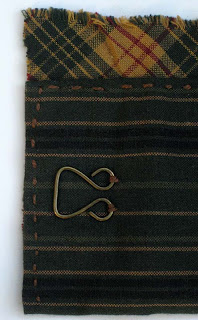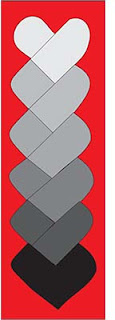.....Presenting
Quiltlet #4! It's an upcycled coffee bag cuff, potentially in smell-surround!
In an earlier post, I expressed my passion for
coffee and coffee-themed quilts. Coffee makes me omnipotent and omniscient, for about 47 minutes every morning - better brief than than never! (How deep is my love?
This deep!)
The quiltlet above brings caffeine-fueled creativity to a new level. Genuine coffee accoutrements, including a disassembled coffee bag, and, potentially, coffee molecules, can be included.
But before the directions, excuse a short digression, to share what I learned during several minutes of research into coffee bags.
The technical name is "retort pouches". Fused layers of plastic and metal, they were co-invented by the military and private industry in 1978. The technology spread slowly to the commercial market. Kids' juice drinks were among the early adopters, most notably Capri Suns.
Coffee companies eventually caught on - pouched coffee is lighter than metal cans, reducing shipping costs. Tuna and other seafoods are among the newest converts - but who the heck wants a tuna-scented cuff?(Update: A reader answered this question: Cats and their owners.)
The bad news about retort pouches is that they're not usually recyclable. They go into landfill, or are incinerated. This is hopefully changing; I found several companies online that have developed recyclable versions.
The good news: retort pouches are sturdy, colorful, washable, and...stitchable! So it was inevitable that green-minded sewists and crafters would start eying them flirtatiously; the relationship was consummated, and their spawn was a new subset of crafts. Google "juice pouch crafts" or "juice pouch bags," or "capri sun pouch crafts" - you'll find a ton of of ideas and patterns, especially for tote bags, wallets, coin purses, and, of course, the occasional
prom dress.
It wouldn't be healthy to drink your way to a juice pouch tote bag (let alone a prom dress), not in a short amount of time, anyway. In recent years, health experts have warned children and adults to
cut back on juice consumption. Even 100% fruit juice contains plenty of unnecessary sugars and calories.
Coffee bags, on the other hand, come full of very tasty 100% coffee, beans or ground, which might be very good for you, even if you drink many cups a day. Coffee consumption is associated with a lower risk of cancer, dementia, heart disease, diabetes, depression, humility, etc., according to scientific studies like
these and
these. The day may be coming when we view coffee as a nutrient.
So the first step is to drink a lot of coffee, until the bag is more or less empty. Then, wash it. Or better yet, just wipe it down a bit; but leave in some coffee dust. Yum, it will smell good for a long time and probably not attract vermin?! Isn't it much better to have a roasty fragrance on your wrist than some sappy perfume? (Or tuna?)
However: If you've got a Starbucks coffee pouch, examine it carefully before cutting - some offer a trade-in:
You are supposed to hand over the whole bag to get a free smallest-size cuppa. (I keep intact, rolled up empty Starbucks bags in my purse, ready for barter. My purse smells delicious.)
I chose a Peets' coffee bag for this project, not only because it DIDN'T offer a trade-in, but also because it's a rich chocolate brown, with gold lettering (nice font, too).
You can see the gold lettering better in this back shot of the finished cuff:
Here's an annotated version of the whole cuff:
Cuff ingredients:
- An empty coffee bag (Peet's 'Major Dickason's Blend', in this case. (Delicious, by the way.)
- Brown glass beads shaped like coffee beans (along the top edge. From bead shops or the web);
- 'Burnt' wooden buttons (along the top. Evocative of roasting.);
- Vintage gold faceted glass bead (on the 'wave.');
- Small brown/black/white glass trade beads (along the bottom.);
- Two brown abstract print fabrics (fabrics A and B);
- Two coffee-themed novelty fabrics: the small black-and-white tumbling coffee cups (fabric C), and the large yellow cup (fabric D).
- Backing fabric (Brown heart print, shown at the bottom of this post.) This is fabric E.
- Two small black sew-in snaps;
- Thread: gold metallic (from Superior) for zig-zag wave; 'invisible' nylon thread to applique the cup; and brown thread to applique the coffee bag and the 'wave'.
- Strip of batting, same height and width as unfinished bracelet.
My finished size: 9 1/4" x 4 1/4". This size is good for a wallhanging, paper weight, pencil holder,
coffee-scented votive-candle-surround, etc.
But this is important: If you want your cuff to actually function as an actual cup cuff (to keep hands cool when handling a hot paper cup ), you need to make it FINISH at 9 3/4" - 10" long x 2 1/2" high or shorter (under 2 1/2"). So adapt these measurements as needed.
I always use 1/4" seam allowances.
During this project, I found that coffee bags are very easy to stitch. No need to turn under edges. They glide easily under the presser foot. The only danger is sewing stitches too closely together - that can cause the holes to rip through. Use a long stitch length, and a thin needle, like a microtex.
For information about how to search out coffee-themed novelty fabrics online (like fabrics C and D), scroll down to the very bottom of
my earlier coffee post.
1. Cut a rectangle of fabric A (dark brown fabric) 3 1/2" x 9 3/4".
2. Cut two strips of fabric B (light brown fabric), each 1" x 9 3/4".
3. Stitch the two B strips to the top and bottom edges of the A strip.
4. Cut a rectangle from the coffee bag to approximately 2" x 9 3/4". Center it horizontally on the AB unit and stitch it down with brown thread, using a long zig zag. (A tight zig zag would be bad because the needleholes would be close together and might rip through the bag.)
5. If you have a fabric C for the frontmost 'wave' (mine is black and white, with tossed coffee cups), fuse a strip that's about 2.5" x 8 3/4" to a piece of fusible interfacing (This is optional; interfacing just makes it easier to handle.)
6. Figure out with tracing paper the shape of the wave. I wanted to cover "Peets" but leave the word "coffee". Once you have the shape, cut it from fabric C. Glue-stick the wave into position on top of the bag rectangle.
7. From a novelty fabric (fabric D) that has a large (1.5"-3") coffee cup on it: rough-cut around a cup, leaving a quarter inch or more fabric around the motif. Fuse the fabric cup onto fusible interfacing or paper backed fusible web. Once fused, cut closely around the cup.
8. Place the cup in position. You can use a glue stick again to temporarily hold it in place. Stitch down with a loose zig zag, using invisible thread .
9. Cut a piece of backing fabric slightly larger than your finished top. In my case, it's 4 3/4" x 9 3/4" (or the same size as your finished top). This is fabric E. (It's the heart fabric shown below).
9. Cut a piece of thin batting (I like Warm'n'Natural) to the same size as the backing fabric.
10. Stack components: Batting on the bottom, backing on top of it good side up; then your pieced top, good side down. Pin in place, but don't put any pins through the coffee bag area. Beginning on one long side, stitch almost all the way around, leaving a 2" or more gap.
11. Trim back the corners, cutting near but not through the stitching line.
12. Gently pull out the front.
13. Press the edges (but keep the iron away from the bag! Finger-press those areas.)
14. Hand-stitch the gap closed.
15. I did a decorative machine wave stitch with metallic thread over the seams where fabric A meets fabric B. I used invisible thread in the bobbin.
16. Hand stitch beads and buttons wherever you please, using thread that blends well with the backing.
17. Hand stitch snaps to the corners. Look at the first picture above - see the black snap-halves in the two far right corners? The corresponding snap halves can be seen in the far right corners of the heart backing fabric picture below.
18. You're done! Send pictures! You definitely deserve a nice fresh cup of Joe! Trade in that Starbucks bag!
(P.S. Here's the back side. Black snaps are on the upper and lower right hand corners. It still needs a loop for hanging in the middle top.)

Scroll about 2/3rds of the way down the page for a nice tote:
http://meggitymegs.wordpress.com/tag/crafts/
Quilter Eleanor Levie has made wonderful concoctions from coffee bags and other trash. She calls it her ReUse series:
http://www.eleanorlevie.com/gallery.php. My favorite:
http://www.eleanorlevie.com/gallery-detail.php?cat=43&ID=0.

































































